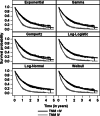A parametric additive hazard model for time-to-event analysis
- PMID: 38402386
- PMCID: PMC10893628
- DOI: 10.1186/s12874-024-02180-y
A parametric additive hazard model for time-to-event analysis
Abstract
Background: In recent years, the use of non- and semi-parametric models which estimate hazard ratios for analysing time-to-event outcomes is continuously criticized in terms of interpretation, technical implementation, and flexibility. Hazard ratios in particular are critically discussed for their misleading interpretation as relative risks and their non-collapsibility. Additive hazard models do not have these drawbacks but are rarely used because they assume a non- or semi-parametric additive hazard which renders computation and interpretation complicated.
Methods: As a remedy, we propose a new parametric additive hazard model that allows results to be reported on the original time rather than on the hazard scale. Being an essentially parametric model, survival, hazard and probability density functions are directly available. Parameter estimation is straightforward by maximizing the log-likelihood function.
Results: Applying the model to different parametric distributions in a simulation study and in an exemplary application using data from a study investigating medical care to lung cancer patients, we show that the approach works well in practice.
Conclusions: Our proposed parametric additive hazard model can serve as a powerful tool to analyze time-to-event outcomes due to its simple interpretation, flexibility and facilitated parameter estimation.
Keywords: Additive hazard; Parametric modeling; Survival analysis; Time-to-event model.
© 2024. The Author(s).
Conflict of interest statement
Competing interests. The authors declare no competing interests.
Figures





References
MeSH terms
LinkOut - more resources
Full Text Sources
Research Materials

